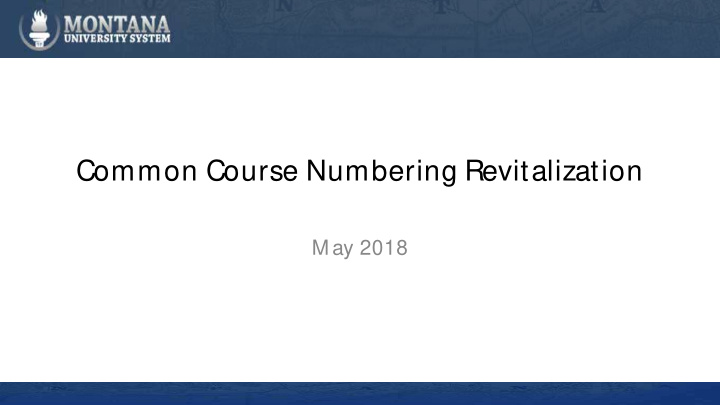



Common Course Numbering Revitalization M ay 2018
Why is CCN Important? � 1 in 6 students will transfer within the M US at some point. � CCN facilitates movement of around 20,000 courses each year. � CCN alleviates effort required of students and advisors when determining how courses transfer.
CCN Learning Outcomes https:/ /ccn.mus.edu/ search/
CCN Learning Outcomes https:/ /ccn.mus.edu/ search/ Courses deemed equivalent if outcomes overlap by > 80%
Our Challenge � Drift Totals by Campus M issing Outcomes Total CCN Courses S ystemwide 47% of courses in CCN lack BFCC 49 91 CC learning outcomes 201 332 DCC 389 504 FVCC 536 953 GC 14 220 GFC 172 445 Question: HC 150 423 HCMT 128 160 MC 158 469 10 years into CCN, what ensures courses MCC 238 409 MSU 13 2137 remain ‘equivalent’? MSUB 519 1057 MSUN 535 680 TECH 604 805 UM 1506 2565 UMW 407 754 SYSTEM 5619 12004 Note: Updated 4/ 30/ 18
CCN Quality Control M otivation Action Are all undergraduate courses listed in the Level I M onthly audits CCN System? Do all courses in the CCN system have up- M onthly audits & new campus Level II to-date outcomes? processes Are courses in the CCN system regularly Level III ? compared to ensure they remain equivalent? Are CCN courses useful in a student ’s Level IV ? program of study once they transfer?
CCN Quality Control Are all undergraduate courses listed in the Level I M onthly audits CCN System? Do all courses in the CCN system have up- M onthly audits & new campus Level II to-date outcomes? processes BY SEPTEM BER, 2018: All lower-division courses accurate in CCN database BY J ANUARY , 2019: All courses accurate in CCN database
CCN Quality Control Are courses in the CCN system regularly Level III ? compared to ensure they remain equivalent? Occasionally, we need disciplinary committees to meet and review course outcomes for consistency. � How can we best coordinate? � What technological tools can speed this process? � What committees? What cycle?
CCN Quality Control Are CCN courses useful in a student ’s Level IV ? program of study once they transfer? How can students who intend to transfer navigate a ‘garden of forking paths’ into a program of study?
CCN Quality Control Are CCN courses useful in a student ’s Level IV ? program of study once they transfer? One approach � SUNY Transfer Paths � Disciplinary committees define common lower division requirements for related degrees � M ake transparent what students need to take and where related degrees diverge in the lower division
CCN Quality Control CCN Subgroup: Nathan Lindsay, Charity Walters, Rachel Anderson, Garth Sleight
CCN Quality Control CCN Subgroup: Nathan Lindsay, Charity Walters, Rachel Anderson, Garth Sleight Commonly Transferred Courses Commonly Transferred Rubrics Rubric Number N Rubric N WRIT 101 1042 M 1906 PSYX 100 789 WRIT 1461 M 121 459 PSYX 1154 CHM Y 121 352 CHM Y 962 SOCI 101 346 BIOH 673 CAPP 120 320 BIOB 629 BIOB 101 240 CAPP 579 STAT 216 240 M USI 574 Source: M US Student Data Warehouse Note: Tracks courses passed prior to transfer for students in the 2011 cohort
Fall Pilot Our Proposal Pilot disciplinary committee process in Fall 2018 on five rubrics: � Focus on most transferred courses / rubrics � Focus on rubrics that differ markedly across lower division courses
Fall Pilot Disciplinary Committee Charge 1. Compare outcomes among commonly transferred or repeated courses to ensure outcomes remain within 80%. 2. For disciplines with B.A./ B.S. degrees on multiple campuses, develop academic maps showing recommended course of study in the first two years. 3. Briefly review full array of courses within rubric to identify courses that appear similar/ duplicative and might be amended so they are equivalent (With a goal to make offerings at the lower division more consistent).
Fall Pilot From pilots, we will develop a process for regular review (presented to BOR M ay 2019)
QUESTIONS?
Recommend
More recommend